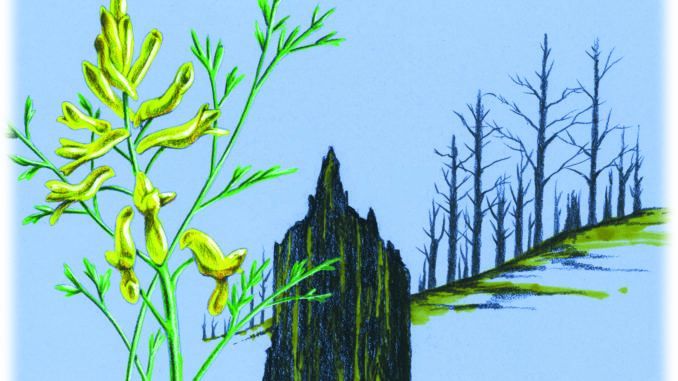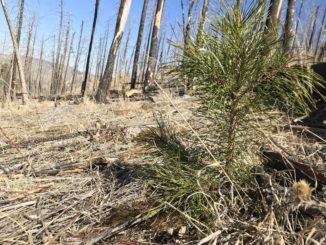
By Gary Raham, Science writer & illustrator
Fire remakes the world, whether started by a lightning bolt or a human hand. Nature began the process over 400 million years ago when plants invaded land and left their combustible remains behind. Sometimes—most notably after major extinction events where fires contribute to the reigning chaos of volcanic eruptions or asteroid strikes—fires stain rock layer junctions with pencil lines of dark carbon. The human species (literally) picked up nature’s torch and continues to shape the world—sometimes intentionally, sometimes not. As we recover from the personal and public tragedies of Colorado’s fire season, we should focus on how to manage fire to shape the world we want to live in. Scientists believe that management in the 21st century will be like taking aim at a target riding on the back of an accelerating behemoth: climate change.
Fire turns forests to ash. Ash enriches soil. The intense heat of fire often stimulates the germination of conifer seeds. The seeds of flowering plants either sprout from hardy survivors, parachute to a landing after riding a gust of wind, or ride to fertile ground on the hair or in the droppings of returning animals. Studies of the Hayman fire of 2002, as reported by USDA researcher Paula Fornwalt in 2006, showed that 80% of plant species in pre-fire surveys eventually returned, regardless of fire severity. The process started with fast-growing forbs—especially the yellow-flowered Corydalis aurea, often referred to as “golden smoke” or “scrambled eggs.” Other returning members of the understory included Front Range beardtongue and Fendler’s ragwort. Ultimately, ponderosa pine and Douglas fir regenerated, at least in those areas where surviving older trees provided a seed source.
The ordered change in living communities after a disaster, from pioneering forbs to bushy understory to trees (depending on soil, temperature, and moisture), is called succession—a term whose roots go back as far as the 14th century. Very intense fires can totally remove trees from an area and eliminate a source of seeds for forest regeneration. It appears humans have understood this on a practical level for much of their history, although we have been slow to acknowledge the skills of our forebears. Award-winning author Charles C. Mann reminded readers in his 2005 book, 1491, New Revelations of the Americas Before Columbus, that Native Americans shaped the ecology of North America for thousands of years before the arrival of Europeans.
He quotes from the 17th century journals of a Dutch colonist describing the annual forest fires created by the Haudenosaunee along the shores of the Hudson and Mohawk rivers. He notes that periodic fires created vast park-areas beneath towering but scattered trees in eastern parts of the continent but goes on to say that “Indian fire had its greatest impact in the middle of the continent, which Native Americans transformed into a prodigious game farm.” Fires maintained grassland habitats that supported the vast herds of buffalo and other grazers that Native Americans hunted. “Carrying their flints and torches, Native Americans were living in balance with nature—but they had their thumbs on the scale.”
As complex Native American societies disintegrated from the devastating population losses of European diseases and sense of manifest destiny, trees reclaimed large parts of Wisconsin, Illinois, Kansas, Nebraska, and other Midwestern states, and settlers forgot what the landscape had looked like before. Besides, house building and agriculture doesn’t fit well with the massive, uncontrolled use of fire.
Now, hundreds of millions of North Americans need secure living space, a reliable source of food, and complex transportation networks. They also need healthy ecosystems to provide the services of clean air, potable water and recreation. Fire plays a role in maintaining viable ecosystems. Authors William T. Sommers, Stanley G. Coloff, and Susan G. Conard point out in “Synthesis of Knowledge: Fire History and Climate Change,” a study produced by George Mason University in 2009, fire management in the 21st century won’t even look the same as it did in the 20th century—largely because of climate change. “Fire regimes will change, fire seasons will be longer, peak season periods of heat and drought will amplify, fuel conditions and ignition patterns will change in varying ways.”
A warming climate brings more energy into the system. Energy, like the heating element in those now quaint “lava lamps,” roils Earth’s liquids and gases in ways that can be simultaneously beautiful and destructive. The Mason University study points out that major wind systems like the Santa Ana and major ocean current systems that control El Nino events that have worldwide impacts on weather systems are in a state of flux. “It is important to recognize,” they say, “that the rates of change may be considerably more rapid than during most periods in the Holocene.”
The Holocene refers to the last 12,000 years or so since major continental glaciers retreated. Some scientists suggest we should call this period the Anthropocene in recognition of the impact humans have had on climate ever since the practice of organized agriculture. It’s comforting that these scientists are taking the long view of things. Understanding long-term oscillations in global climate before human involvement provide the keys to understanding the human role in modern climate change.
Sommers et al conclude by saying, “The option of restoring future ecosystems to what they once were will simply not exist in the 21st century. Instead, adapting ecosystems, to be fully functional within the bounds of future climate and getting them there with likely increased fire accelerating the transition, is the challenge to be addressed.”
There’s nothing like blazing, uncontrolled forest fires to focus our attention on the specifics of that challenge.
Reprinted with permission from the Harvest 2012 issue of Colorado Gardener magazine
Support Northern Colorado Journalism
Show your support for North Forty News by helping us produce more content. It's a kind and simple gesture that will help us continue to bring more content to you.
BONUS - Donors get a link in their receipt to sign up for our once-per-week instant text messaging alert. Get your e-copy of North Forty News the moment it is released!
Click to Donate



